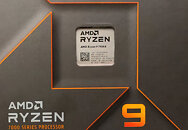- Joined
- Oct 9, 2007
- Messages
- 47,244 (7.54/day)
- Location
- Hyderabad, India
| System Name | RBMK-1000 |
|---|---|
| Processor | AMD Ryzen 7 5700G |
| Motherboard | ASUS ROG Strix B450-E Gaming |
| Cooling | DeepCool Gammax L240 V2 |
| Memory | 2x 8GB G.Skill Sniper X |
| Video Card(s) | Palit GeForce RTX 2080 SUPER GameRock |
| Storage | Western Digital Black NVMe 512GB |
| Display(s) | BenQ 1440p 60 Hz 27-inch |
| Case | Corsair Carbide 100R |
| Audio Device(s) | ASUS SupremeFX S1220A |
| Power Supply | Cooler Master MWE Gold 650W |
| Mouse | ASUS ROG Strix Impact |
| Keyboard | Gamdias Hermes E2 |
| Software | Windows 11 Pro |
AMD's upcoming Ryzen 9 7950X 16-core processor can boost at speeds of up to 5.85 GHz, even though its maximum boost frequency in the specs is 5.70 GHz. The processor needs temperatures below 50°C to boost up to 5.85 GHz. Above these temperatures, it will only boost up to the 5.70 GHz on the tin. There are four frequencies to keep in mind about the 7950X. First is the base frequency, of 4.50 GHz. Next up, is the all-core boost frequency, of 5.10 GHz. This is the frequency at which the processor can run all 16 of its cores, provided it stays away from the 95°C temperature throttle. 5.70 GHz is the maximum boost frequency you'll get on "some" of the cores if the temperature is maintained between 50-95°C. If you're able to keep temperature below 50°C, the processor can boost up to 5.85 GHz. AMD refers to 5.85 GHz as the "peak clock."
To be able to hit peak clocks, you should ideally need some serious cooling, such as a 360 mm DIY liquid cooling setup, or a 420 mm AIO CLC; however in some circumstances, such as the system starting up from a cold-boot in a room with low ambient temperatures, the processor should hit peak clocks as it's approaching the 50°C-mark. AMD is making no pretenses that the 7950X is a high-power chip. Its TDP is rated at 170 W, and its PPT (package power tracking) limit at 230 W. By setting the TDP at 170 W from the get go, AMD is hinting that one can forget about aftermarket tower-type air-cooling, and head straight to AIO liquid cooling.

View at TechPowerUp Main Site | Source
To be able to hit peak clocks, you should ideally need some serious cooling, such as a 360 mm DIY liquid cooling setup, or a 420 mm AIO CLC; however in some circumstances, such as the system starting up from a cold-boot in a room with low ambient temperatures, the processor should hit peak clocks as it's approaching the 50°C-mark. AMD is making no pretenses that the 7950X is a high-power chip. Its TDP is rated at 170 W, and its PPT (package power tracking) limit at 230 W. By setting the TDP at 170 W from the get go, AMD is hinting that one can forget about aftermarket tower-type air-cooling, and head straight to AIO liquid cooling.

View at TechPowerUp Main Site | Source







 .
.